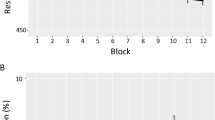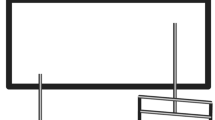Abstract
At least five earlier studies could not find effector-dependent learning in the keying version of the serial reaction time (RT) task. Experiment 1 examined whether effector-dependent learning occurs when participants practice the serial RT task with three fingers of one hand for about 1,300 sequence repetitions instead of the more common 50–100 repetitions. The results confirm that, following extended practice, sequence learning produces an effector-dependent component. Specifically, an unpracticed hand executed a practiced sequence slower than a practiced hand. However, Experiment 2 showed that effector-dependent sequence learning develops only when fingers of one hand are used, suggesting that effector-dependent sequence learning involves adjustment to the mechanical interactions between the fingers of one hand. In addition, when sequences had been practiced with one hand, mirror versions of the practiced sequences in both experiments showed moderate transfer. But when practiced with two hands no transfer to a mirrored version of the sequence was observed. This suggests that only practice with one hand produces a representation that facilitates the execution of mirror sequences. Generally, the same results were found in more or less aware participants, congruent with the idea that the effector-dependent representation and the representation allowing transfer to mirror sequences are implicit.


Similar content being viewed by others
Notes
As the frequencies of the individual keys were unequal, part of the learning effect can be explained by frequency learning. However, frequency learning still implies an effector-independent effect and, hence, cannot be responsible for effector-dependent sequence learning.
References
Bapi, R. S., Doya, K., & Harner, A. M. (2000) Evidence for effector independent and dependent representations and their differential time course of acquisition during motor sequence learning. Experimental Brain Research, 132, 149–162.
Berkinblit, M. B., & Feldman, A. G. (1988). Some problems of motor control. Journal of Motor Behavior, 20, 369–373.
Buchner, A., Steffens, M. C., Erdfelder, E., & Rothkegel, R. (1997). A multinomial model to assess fluency and recollection in a sequence learning task. Quarterly Journal of Experimental Psychology, Human Experimental Psychology, 50A, 631–663.
Clohessy, A. B., Posner, M. I., & Rothbart, M. K. (2001). Development of the functional visual field. Acta Psychologica, 106, 51–68.
Cohen, A., Ivry, R. B., & Keele, S. W. (1990). Attention and structure in sequence learning. Journal of Experimental Psychology: Learning, Memory, and Cognition, 16, 17–30.
Criscimagna-Hemminger, S. E., Donchin, O., Gazzaniga, M. S., & Shadmehr, R. (2003). Learned dynamics of reaching movements generalize from dominant to nondominant arm. Journal of Neurophysiology, 89, 168–176.
Eimer, M., Goschke, T., Schlaghecken, F., & Stürmer, B. (1996). Explicit and implicit learning of event sequences: Evidence from event-related brain potentials. Journal of Experimental Psychology: Learning, Memory, and Cognition, 22, 970–987.
Gentner, D. R. (1987). Timing of skilled motor performance: Test of the proportional duration model. Psychological Review, 94, 255–276.
Gentner, D. R., Larochelle, S., & Grudin, J. T. (1988). Lexical, sublexical, and peripheral effects in skilled typewriting. Cognitive Psychology, 20, 524–548.
Grafton, S. T., Hazeltine, E., & Ivry, R. B. (1995). Functional mapping of sequence learning in normal humans. Journal of Cognitive Neuroscience, 7, 497–510.
Grafton, S. T., Hazeltine, E., & Ivry, R. B. (1998). Abstract and effector-specific representations of motor sequences identified with PET. Journal of Neuroscience, 18, 9420–9428.
Grafton, S. T., Hazeltine, E., & Ivry, R. B. (2002). Motor sequence learning with the nondominant left hand. A PET functional imaging study. Experimental Brain Research, 146, 369–378.
Heuer, H. (1996). Coordination. In H. Heuer & S. W. Keele (Eds.), Handbook of perception and action, Vol. 2 (pp. 121–180). London: Academic.
Heyes, C. M., & Foster, C. L. (2002). Motor learning by observation. Evidence from a serial reaction time task. Quarterly Journal of Experimental Psychology, 55A, 593–607.
Hicks, R. E. (1974). Asymmetry of bilateral transfer. American Journal of Psychology, 87, 667–674.
Hikosaka, O., Nakahara, H., Rand, M. K., Sakai, K., Lu, X., Nakamura, K., Miyachi, S., & Doya, K. (1999). Parallel neural networks for learning sequential procedures. Trends in Neuroscience, 22, 465–471.
Hikosaka, O., Sakai, K., Nakahara, H., Lu, X., Miyachi, S., Nakamura, K., & Rand, M. K. (2000). Neural mechanisms for learning of sequential procedures. In M. S. Gazzaniga (ed.), The new cognitive neurosciences (pp. 553–572). Cambridge, MA: MIT.
Hlûstik, P., Solodkin, A., Gullapalli, R. P., Noll, D. C., & Small, S. L. (2002). Functional lateralization of the human premotor cortex during sequential movements. Brain & Cognition, 49, 54–62.
Hoffmann, J., Sebald, A., & Stöcker, C. (2001). Irrelevant response effects improve serial learning in SRT tasks. Journal of Experimental Psychology: Learning, Memory, and Cognition, 27, 470–482.
Howard, J. H., Mutter, S. A., & Howard, D. V. (1992). Serial pattern learning by event observation. Journal of Experimental Psychology: Learning, Memory, and Cognition, 18, 1029–1039.
Jordan, M. I. (1995). The organization of action sequences: Evidence from a relearning task. Journal of Motor Behavior, 27, 179–192.
Karni, A., Meyer, G., Rey-Hipolito, C., Jezzard, P., Adams, M. M., Turner, R., & Ungerleider, L. G. (1998). The acquisition of skilled motor performance: Fast and slow experience-driven changes in primary motor cortex. Proceedings of the National Academy of Sciences USA, 95, 861–868.
Keele, S. W., Jennings, P., Jones, S., Caulton, D., & Cohen, A. (1995). On the modularity of sequence representation. Journal of Motor Behavior, 27, 17–30.
Keele, S. W., Ivry, R. B., Hazeltine, E., Mayr, U., & Heuer, H. (2003). The cognitive and neural architecture of sequence representations. Psychological Review, 110, 316–339.
Kent, R. D., & Minifie, F. D. (1977). Coarticulation in recent speech production models. Journal of Phonetics, 5, 115–133.
Koch, I., & Hoffmann, J. (2000). The role of stimulus-based and response-based spatial information in sequence learning. Journal of Experimental Psychology: Learning, Memory, and Cognition, 26, 863–882.
Kornbrot, D. E. (1989). Organization of keying skills: The effect of motor complexity and number of units. Acta Psychologica, 70, 19–41.
Lahy, J. M. (1924). Motion study in typewriting. In Studies and reports: Series J (Educational), 3. Geneva: International Labour Office.
Lindemann, P. G., & Wright, C. E. (1998). Skill acquisition and plans for actions: Learning to write with your other hand. In D. Scarborough & S. Sternberg (Eds.), Methods, models, and conceptual issues. An invitation to cognitive science, Vol. 4 (pp. 523–584). Cambridge, MA: MIT.
MacKay, D. G. (1982). The problems of flexibility, fluency, and speed-accuracy trade-off in skilled behavior. Psychological Review, 89, 483–506.
Mayr, U. (1996). Spatial attention and implicit learning: Evidence for independent learning of spatial and nonspatial sequences. Journal of Experimental Psychology: Learning, Memory, and Cognition, 22, 350–364.
McDowell, M. J., & Wolff, P. H. (1997). A functional analysis of human mirror movements. Journal of Motor Behavior, 29, 85–96.
Nattkemper, D., & Prinz, W. (1997). Stimulus and response anticipation in a serial reaction task. Psychological Research, 60, 98–112.
Nissen, M. J., & Bullemer, P. (1987). Attentional requirements of learning: Evidence from performance measures. Cognitive Psychology, 19, 1–32.
Park, J.-H., & Shea, C. H. (2003). Effect of practice on effector independence. Journal of Motor Behavior, 35, 33–40.
Parker-Taillon, D., & Kerr, R. (1989). Manual asymmetries within the performance of a complex motor task. Human Movement Science, 8, 33–44.
Pascual-Leone, A., Grafman, J., & Hallett, M. (1994). Modulation of cortical motor output maps during development of implicit and explicit knowledge. Science, 263, 1286–1289.
Pew, R. W. (1974). Levels of analysis in motor control. Brain Research, 71, 393–400.
Rand, M. K., Hirosaka, O., Miyachi, S., Lu, X., Nakamura, K., Kitaguchi, K., & Shimo, Y. (2000). Characteristics of sequential movements during early learning in monkeys. Experimental Brain Research, 131, 293–304.
Reed, J., & Johnson, P. (1994). Assessing implicit learning with indirect tests: Determining what is learned about sequence structure. Journal of Experimental Psychology: Learning, Memory, and Cognition, 20, 584–594.
Rosenbaum, D. A., Meulenbroek, R. J., & Vaughan, J. (1999). Remembered positions: Stored locations or stored postures? Experimental Brain Research, 124, 503–512.
Rüsseler, J., & Rösler, F. (2000). Implicit and explicit learning of event sequences: Evidence for distinct coding of perceptual and motor representations. Acta Psychologica, 104, 45–67.
Schmuckler, M. A., & Bosman, E. L. (1997). Interkey timing in piano performance and typing. Canadian Journal of Experimental Psychology, 51, 99–111.
Schneider, W., Zuccolotto, A., & Tirone, S. T. (1993). Time-stamping computer events to report 1-msec accuracy of events in the Micro Experimental Laboratory. Behavior Research Methods, Instruments, & Computers, 25, 276–280.
Seger, C. A. (1994). Implicit learning. Psychological Bulletin, 115, 163–196.
Shaffer, L. H. (1975). Multiple attention in continuous verbal tasks. In P. M. A. Rabbitt & S. Dornic (Eds.), Attention and performance V (pp. 157–167). New York: Academic.
Stadler, M. A. (1989). On learning complex procedural knowledge. Journal of Experimental Psychology: Learning, Memory, and Cognition, 15, 1061–1069.
Sternberg, S., Monsell, S., Knoll, R. L., & Wright, C. E. (1978). The latency and duration of rapid movement sequences: comparisons of speech and typewriting. In G. E. Stelmach (Ed.), Information processing in motor control and learning (pp. 117–152). New York: Academic.
Verwey, W. B., & Wright, D. (2004). Effector-independent and effector-dependent learning in the discrete sequence production task. Psychological Research, 68, 64–70.
Wachs, K., Pascual-Leone, A., Grafman, J., & Hallett, M. (1994). Intermanual transfer of implicit knowledge of sequential finger movements. Neurology, 44, Supplement 2, 805S.
Willingham, D. B. (1998). A neuropsychological theory of motor skill learning. Psychological Review, 105, 558–584.
Willingham, D. B. (1999). Implicit motor sequence learning is not purely perceptual. Memory and Cognition, 27, 561–572.
Willingham, D. B., Nissen, M. J., & Bullemer, P. (1989). On the development of procedural knowledge. Journal of Experimental Psychology: Learning, Memory, and Cognition, 15, 1047–1060.
Willingham, D. B., Wells, L. A., Farrell, J. M., & Stemwedel, M. E. (2000). Implicit motor sequence learning is represented in response locations. Memory & Cognition, 28, 366–375.
Wolff, P. H., Gunnoe, C. E., & Cohen, C. (1983). Associated movements as a measure of developmental age. Developmental Medicine and Child Neurology, 25, 417–429.
Zirngibl, C., & Koch, I. (2002). The impact of response mode on implicit and explicit sequence learning. Experimental Psychology, 49, 153–162.
Author information
Authors and Affiliations
Corresponding author
Rights and permissions
About this article
Cite this article
Verwey, W.B., Clegg, B.A. Effector dependent sequence learning in the serial RT task. Psychological Research 69, 242–251 (2005). https://doi.org/10.1007/s00426-004-0181-x
Received:
Accepted:
Published:
Issue Date:
DOI: https://doi.org/10.1007/s00426-004-0181-x




